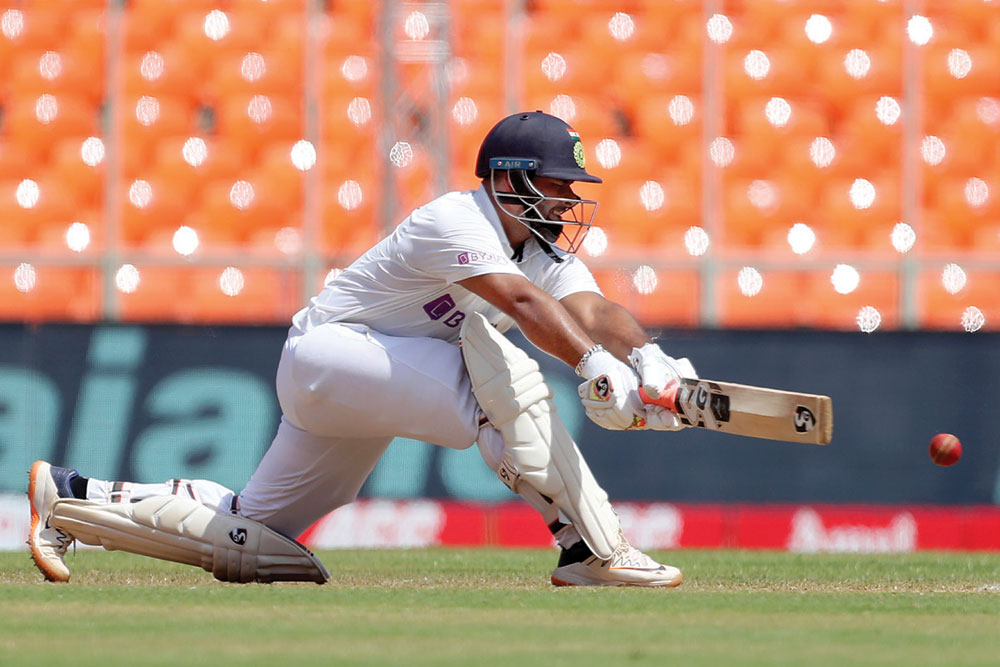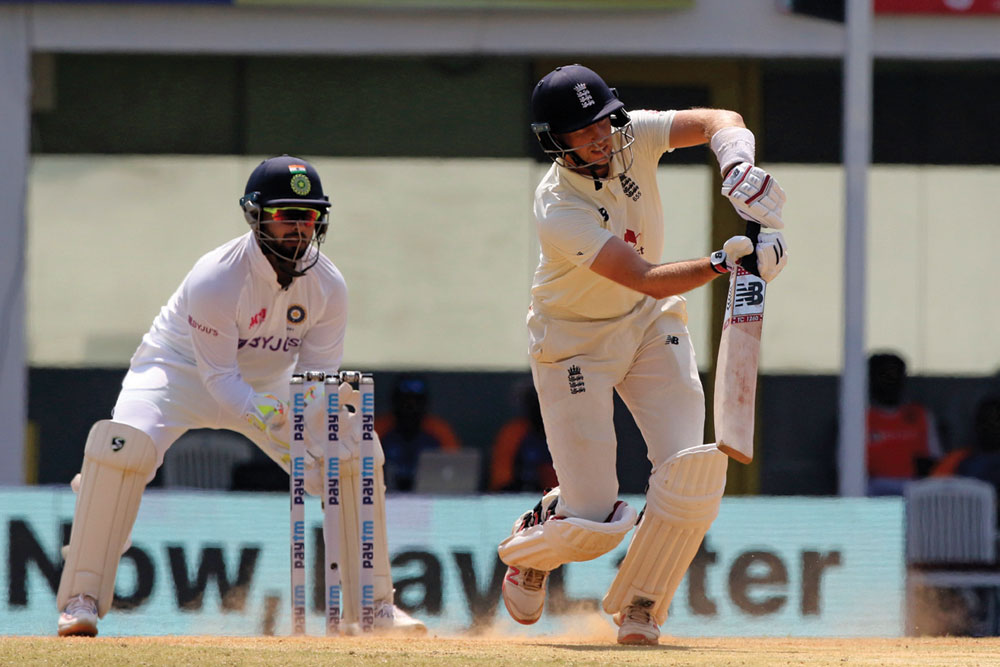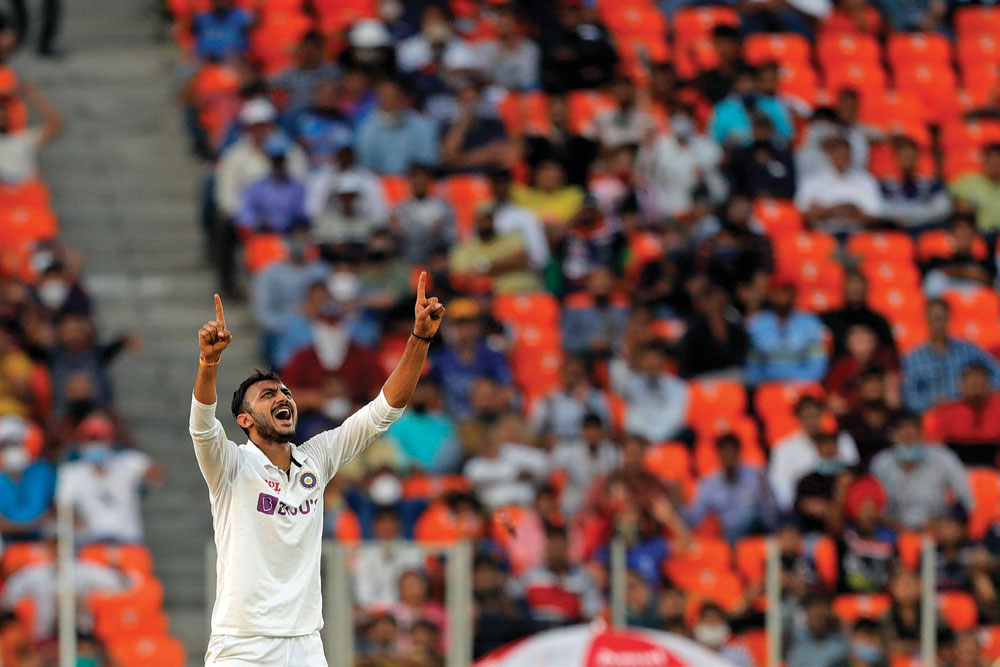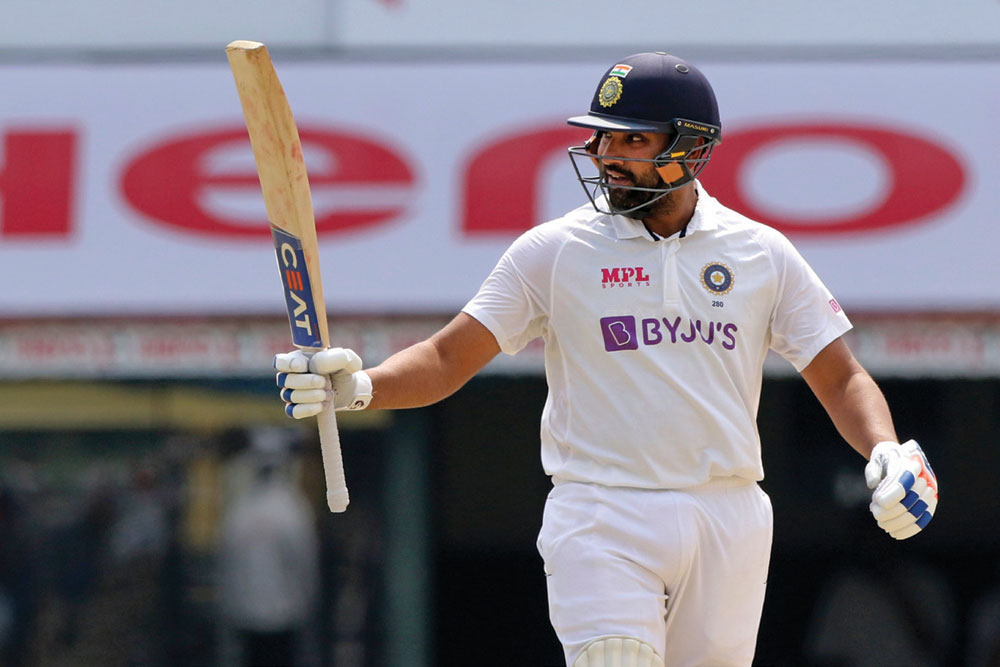Imperfect Pitch
There is more to cricket than winning, even deservedly
 James Astill
James Astill
 James Astill
James Astill
 |
12 Mar, 2021
|
12 Mar, 2021
/wp-content/uploads/2021/03/Imperfectpitch1.jpg)
India captain Virat Kohli (extreme left) and teammates after winning the test series against England at Narendra Modi Stadium in Ahmedabad, March 6 (Photo: AP)
GEORGE BERNARD SHAW, the great Irish playwright and friend of Mahatma Gandhi and Rabindranath Tagore, once quipped that baseball’s single great advantage over cricket was that the American game was “sooner ended”. There were times during the madcap Test series that India and England have just concluded in Ahmedabad when it seemed as if they were hellbent on proving that wisecrack wrong.
It was one of the shortest four-Test series played, lasting just 14 days. India won the third Test,played in the cavernous new Narendra Modi Stadium, by 10 wickets in less than two days. The total number of runs scored in the game, after England were skittled for 112 in their first innings and just 81 in the second, was 387. That was 47 less than Australia and New Zealand bludgeoned in a T20 game played at the same time.
Eight-hundred-and-forty-two balls were bowled in the Test—the lowest tally in a Test match since 1935. By way of contrast, the most pitches ever recorded in an organised baseball game, played between the Pawtucket Red Sox and Rochester Red Wings in 1981,was 882. Bernard Shaw, it is interesting to note, once also claimed, “The longer I live, the more I realise that I am never wrong about anything.” At least his early support for Indian independence was well-judged.
The India-England series was strange, given the Covid-19-induced circumstances in which it was played, even before the wickets started tumbling. Both sets of players met in Chennai elated by recent successes: India by their momentous series win in Australia and England by their more routine one in Sri Lanka. And yet they were drained by months of living in biosecure team bubbles, confined to a hotel room, a gym and a few odd trips to the nets. This seemed especially concerning given the jampacked cricket schedule in the coming months.

India’s players are scheduled to play 14 Tests, 16 one-day internationals and at least 23 T20 internationals in 2021, including a T20 World Cup in India in October and November, and an Indian Premier League (IPL) season. England’s are down for a staggering 17 Tests; most will also play in the IPL. To lighten the load, the England management adopted a squad-based selection policy, allowing it to cycle players in and out of the bubble between breaks back home. It contributed to England’s embarrassing series defeat.
The rotation policy ensured that England fielded its best team at no point during the series. Jonny Bairstow, one of England’s better players of spin, had looked in fine touch in Sri Lanka, then flew home to spend two weeks walking his dogs in wintry Yorkshire, only to re-emerge for the two Tests in Ahmedabad hopelessly out of form.
Jos Buttler, perhaps the one English batsman able to change a game in the spectacular way Rishabh Pant did, with his swashbuckling hundred in the fourth Test, only played in the first game. He watched Pant’s century from the England team hotel, having also jetted in from a holiday back home. Clearly, every team must look after its players’ wellbeing. Yet this seemed like a case of priorities gone awry. An India Test series is now prized by England players and supporters above all else except the Ashes. And English cricket does not have the depths of talent, in batting and spin-bowling especially, to take on India’s with their B team. Even England’s best side has only one batsman, Joe Root, averaging above 40.

India’s has six batters with at least that average—if you assume the novice bowling all-rounder Washington Sundar makes the team. That speaks to a more egregious demonstration of wrongheadedness, the substandard state of the pitches on which the series was played, which in turn explains why the cricket was so manic and curtailed.
Don’t get me wrong. There is obviously nothing wrong with a host country preparing pitches to suit its bowlers. It has ever been thus—and the practice contributes to the great diversity of playing conditions that is one of Test cricket’s strengths. Some—including Virat Kohli—have also argued that the strips of powercake prepared in Chennai and Ahmedabad were all just about fit for Test cricket. There have been worse pitches; though, to be sure, not many or much worse than the crumbling no-man’s land served up for the third Test, the inaugural game in the cavernous new Modi stadium. But these arguments are to some degree moot. Because Indian cricket overseers did not need to go to such lengths to win this series. And it would have been much better, for the game and its Indian chief custodian, if they had not.
Given their cricketing advantages, why did India’s cricket power not have the courage to prepare some spin-friendly test-match pitches, that were nonetheless able to hold together for more than a day or two? India would most likely have won the series anyhow—even if Joe Root had batted in every test as he did in the first. They were too good for England
The Indian team started the series only a few points ahead of the English in the International Cricket Council rankings—yet manifestly far superior. In Indian conditions, Joe Root and Jimmy Anderson are the only England players who could be confident of making it into a combined India-England team. Even in seaming English conditions, only Stuart Broad and Ben Stokes would stand a decent chance of joining them. Not many of the remaining Englishmen would sneak into a combined India-England second team.
In Ravichandran Ashwin, the Indians had the best spinner in the world and therefore the best bowler in Indian conditions.
When he bagged Jofra Archer LBW, in the first England innings of the third Test, he became the second fastest bowler to take 400 Test wickets after Muttiah Muralitharan. And yet he was arguably out-bowled in the series by the wondrous Axar Patel, a 27-year-old debutant slow left-armer. He was drafted into the team with no fanfare for the second Test, and proceeded to take 27 wickets, including four five-wicket hauls, at an average of 10. He should savour that triumph, too. Because once Ravindra Jadeja, a similar bowler, better batsman and worldbeating fielder, returns from injury, Axar faces the axe.
THE GULF BETWEEN the two sides’ batting was equally stark. Rohit Sharma was the batsman of the series. His cool, dashing 161 in the second Test in Chennai was a masterclass in batting on a rank turner. Yet, as in the earlier India-Australia series, India’s batting down the order, by less-heralded stars, was an even more powerful sign of the country’s rise to cricketing domination.

None shone brighter than Rishabh Pant, the 23-year-old wicketkeeper-batsman from Haridwar. Still a relative newcomer to international cricket, he showed up for the recent Australia series overweight and in bad odour with the team management. Seven games later he is India’s next cricketing sensation. He has kept wicket securely and athletically, scored more heavily than any other India batter—and played two of the defining innings of the consecutive series in a flamboyant style which did as much to grind the Australians and English into the dust as the runs he put on the board. In the Australia series, he made a game-saving 97 in Sydney and a sparkling 89 not out to lead India’s stupendous series-clinching win in Brisbane. And in Ahmedabad, the diminutive stroke-player did it again, by launching a magnificent assault on the English bowling which effectively sealed the game and series for India.
He reverse-scooped Anderson for four over the top of the slips early on; he brought up his third century by sweeping Root for six. His self-possession and conviction struck every commentator as emphatically as the catlike agility that allowed him to change his stroke midshot. “I just see the ball and react to it, that’s the USP of my cricket,” he explained with a shrug after that innings. And yet he is much less of a talented dasher than that made him sound. In Ahmedabad, as in Brisbane, he showed a calm awareness of not only how but when to attack—factoring in the state of the game, the pitch and the bowlers. He seemed entirely unfazed and in control. He seemed a veteran of high pressure—which, having played 100 games in the IPL, of course he is.

Right from the tournament’s start, it was clear that T20 would boost India’s talent stocks and certain cricketing skills in particular. The quality of the tournament’s fielding and inventiveness of its strokeplay got better and better year-on-year. Yet what I failed to anticipate, while researching a book on the tournament, The Great Tamasha: Cricket, Corruption and the Turbulent Rise of Modern India, during its 2010 rendition, was how it would inculcate stage presence in the best young Indian stars and steel their nerves.
The step-up from domestic to international cricket is big everywhere, and used to be especially so in India, given the relative weakness of its first-class game. Yet the routine experience of playing intense IPL cricket—before wild crowds in the stadiums and millions at home—is forging India’s young stars in fire. It may not be too much of a stretch to say the Indian game is become newly characterised by the chutzpah and confident its young players are learning in the tournament. Or how else to explain Washington Sundar?
This was a test series memorable, not unlike a T20 game, for searing flashes of individual brilliance, plus a general impression of batsmen, most of them English, being toppled like ninepins. It was unsatisfying and, for the millions of young Indians and British who need introducing to longform cricket’s greatness, no kind of an introduction at all
A FAR MORE LIMITED batsman than Pant, the 21-year-old off-spinner came into the Test side in Brisbane as perhaps India’s fifth-choice spinner and with two first-class centuries to his name. With utter assurance, he has since hit three Test fifties, including an excellent 96 not out in Ahmedabad. It is no coincident that he made his IPL debut at 17 and has played over 50 games in the tournament.
Then why, with such cricketing advantages, did India’s cricket power not have the courage to prepare some spin-friendly Test-match pitches, that were nonetheless able to hold together for more than a day or two? India would most likely have won the series anyhow—even if Root had batted in every Test as he did in the first. They were too good for England. To appreciate what a missed opportunity this was, compare the magnificent afterglow of the Indians’ record-breaking and historic success in Australia with the deflation many felt over the fast and furious England series.
Test cricket is the best game because, extended over five days, it contains so many different dramas and emotional registers. An extended period of struggle and grind is an essential part of that mix. It is the theme from which the later variations emerge, the springboard from which the game’s later dramas erupt. And the last three Tests of the England-India series had not much more than a couple of days of the necessary grind between them.
The result was a series memorable, not unlike a T20 game, for searing flashes of individual brilliance, plus a general impression of batsmen, most of them English, being toppled like ninepins. It was unsatisfying and, for the millions of young Indians and British who need introducing to longform cricket’s greatness, no kind of an introduction at all.
‘Finished in 2 days Not sure if that’s good for test cricket!!’ tweeted Yuvraj Singh in response to the two-day affair in Ahmedabad. ‘If @anilkumble1074 and @habhajan_singh bowled on these kind of wickets they would be sitting on a thousand and 800?’ It got him into hot water with the Jai Hind brigade. But he was merely stating the obvious, for the good of the game he loves, which is a service Indian cricket too often needs.
The writer Ramachandra Guha begins his new cricket memoir, The Commonwealth of Cricket: A Lifelong Love Affair with the Most Subtle and Sophisticated Game Known to Humankind, with a quote from Jack Fingleton imbued with that same spirit: ‘The longer I live, I am pleased to say, the less nationalistic I become.’ To encourage India’s cricket authorities to accrue with their new power over the game a proportionate sense of responsibility for it, more concerned lovers of the game need to show that spirit, as Yuvraj did. It must also be said: Fingleton’s view of his ageing self was a whole lot more appealing than Bernard Shaw’s. The latter was a sourfaced cricket philistine if ever there was one.

/wp-content/uploads/2025/09/Cover-Modi-scaled.jpg)












More Columns
Cautious Pragmatism Harsh V Pant
Let’s Get Pizza Suvir Saran
Sahher’s Star Kaveree Bamzai